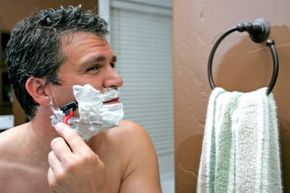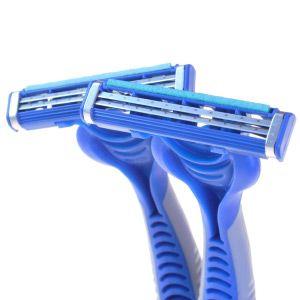Shaving shouldn't be something you dread, but it can be for people who have sensitive skin. That's because they don't have the same protective layer of dead cells, lipids and oils on their skin that most other people have. Without this barrier, potential irritants -- everything from air pollution to fragrance in shaving cream -- can penetrate the skin and cause all sorts of problems.
Instead of enjoying freshly shaven, silky-smooth skin, these people feel nothing but a bumpy rash. Fragrances, alcohol and detergents commonly found in skin-care products can agitate sensitive skin. Be sure to read a shaving cream's label before using it. According to Dr. Leslie Baumann of the Baumann Cosmetic & Research Institute, you should avoid the known irritants below:
Advertisement
Avoiding common irritants can be tough, but don't make the mistake of shaving with just soap and water, or just water. Shaving cream softens the hairs and allows the razor to glide over the skin without nicking or scraping it. But if your shaving cream smells like spring rain or your favorite designer scent, razor damage may be the least of your worries. Many people with sensitive skin also have skin problems such as dryness, eczema (atopic dermatitis) or contact dermatitis, and fragrances more easily irritate those conditions. Even seemingly innocent scents like menthol, eucalyptus, peppermint or lavender can cause shaving bumps, inflammation, itching and a host of other problems.
Another secret to choosing shaving cream for sensitive skin is choosing what to put beneath the shaving cream. Regardless of whether you use shaving cream or gel, you should invest in a bottle of shaving oil that helps keep your skin's protective layer intact. Again, skip the fragrances and the mile-long list of ingredients and look for those produced specifically for sensitive skin.
In addition to choosing the right product, people with sensitive skin need to prepare their skin before shaving. They should spend two to three minutes wetting their faces, legs or any areas needing a shave. Keeping the skin wet, rub the shaving oil onto the skin, and then massage the shaving cream, lotion or gel onto the area that's been prepared.
For best results, you should also use a new, sharp razor to prevent nicks or cuts. Using a new razor for each shave may seem a bit excessive, but it could help protect your skin. Once you get started, be sure to shave in the direction of the hair growth. The shaving oil will create a barrier between the shaving cream and your face, allowing the razor to glide over the area without directly touching your skin. Wash the cut hair out of the razor after each pass.
When you're done, simply wash up with a gentle cleanser followed by a fragrance-free, no-frills moisturizer, and tell your skin, "You're welcome."
Continue reading for lots more information about sensitive skin.
Advertisement


